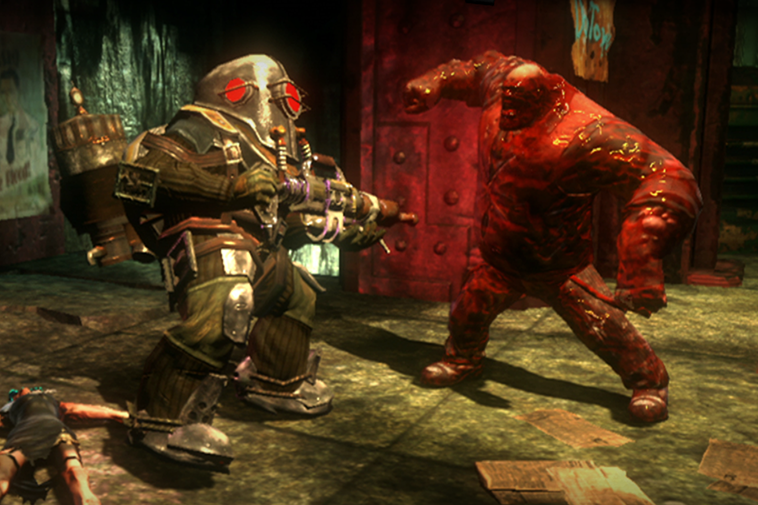Patrick Balthrop may need to be saved from himself. The award-winning sound designer of the BioShock series has no doubt given his friends and family heart palpitations with how often he risks his own well-being in pursuit of the right sound.
“There have been a number of times where I’ve put myself in a dangerous or uncomfortable situation,” he says, immediately recalling some “trips to abandoned World War II armories [that] one could argue I shouldn’t have been in.” Balthrop treated them as a sound designer’s playground, flicking old light switches and throwing, dragging, and scraping found objects together to capture collisions and ambient sounds.
He’s also lugged his gear onto weapon ranges to record the air-sucking thwoomps of grenade launchers and the canon-like cracks of .50 caliber Barrett sniper rifles. He got lost in the deep woods of Vermont once, risking frostbite to get the sound of wind rushing through the trees.
“I ended up sleeping out in a hiker shelter along a trail,” he says. “It was a cold night.”
Oh yeah, he’s also dabbled in electrocution and drowning.
“Authenticity is important to me,” he says. “When I capture source material, I try to do whatever it takes to get the recording I’m after. Chasing the sound … is an integral part of my process.”
That relentless pursuit for authentic sound plays a crucial role in realizing the worlds of the BioShock series, both physically and thematically.

“Rapture and Columbia are both worlds that contrast surreal and realistic sound elements to create an immersive world,” he says. Thus, much of players’ acceptance of these fictional yet familiar cities rests on a precise interplay of surreal and realistic sounds.
In BioShock, for example, Balthrop set the tone for Rapture’s underwater-utopia-gone-wrong with hyper-realistic water sounds such as trickles along the ceiling, splashes from puddles, and the hiss of burst pipes. Such familiar sounds become a menacing presence when balanced against, say, the Big Brother-like buzz of security drones.
Similar sound tactics helped Balthrop realize BioShock Infinite’s floating city of Columbia. Classic American sounds such as fireworks and the clanging of distant church bells foreshadow the cries of Songbird and the klaxon horns of gunned airships.
This meticulous approach to sound design becomes all the more impressive when considering it has to carry out in different ways through the environment, action, and storytelling. Just as the series oscillates between the realistic and surreal, each BioShock game oscillates between intense first-person shooter combat and storytelling laden with the kind of heady themes that consume PhD students.

Like a Nirvana song, Balthrop’s combat sound design goes from stillness to adrenaline-releasing distortion in a millisecond. Gunfire from your right hand, the crackle of electricity in your left, the swell of background music, an oil slick erupting in flames, the thunderous footsteps of a Big Daddy or Handyman may all swell up at once … and then nothing. Nothing except for the trickle of water or a clanging of distant church bells, which now only remind you of the danger ahead.
These moments of chaos are intercut with high-minded stories—BioShock took on objectivism, capitalism, and the police state; BioShock 2 explored Jung and Freud; BioShock Infinite tackled social strife—but for Balthrop, much of supporting these lofty ideas means making each story’s time as authentic as possible. By recreating the sounds of each era—the music, the technology, the dialects—he lets that era’s attitudes infuse the game.
“BioShock Infinite really began to take shape when [the sound] began to support the story in every decision we made,” he says. For example, a 1912 Edison phonograph isn’t just powerful because of its distinct clicks and scratches, but because it was such a new technology for the time, thus embodying the excitement for what the future might bring.
Or consider the bright, energetic quality of the narrator’s Transatlantic dialect in the vigor shorts, exuding the kind of optimism brimming in early 20th century America. And yet there’s something haunting about it, too. We can’t help but see throughout BioShock Infinite the consequences of this optimistic energy being misapplied by both individuals and the state.
“Selling time period was an important contribution to the soundscape of BioShock Infinite,” he says. But the game’s use of alternate timelines gave Balthrop to create some singular juxtapositions. Though every BioShock title used vintage American music, Infinite recast modern music in a style more appropriate to the game’s era.
“The idea to use renditions of popular music in BioShock Infinite was [Ken’s],” says Balthrop. Patrick can give Ken credit for the idea, but the execution was all Balthrop.

Again, it’s his mastery of contrast that sells the songs. Hearing a barbershop rendition of the Beach Boys’ “God Only Knows” not long after hearing an original recording of “(Give Me That) Old-Time Religion” is as disquieting as it is beautiful.
“I’ll never forget listening to the barbershop quartet version of ‘God Only Knows’ for the first time before it was implemented in the build,” he says.
I won’t either. When that song rolled through the end credits of BioShock Infinite, I blubbered like a baby. Which is probably why Balthrop’s willing to go to such life-risking lengths to get the sounds he needs: audio has strange powers over the human mind.
Image via jit on Flickr
